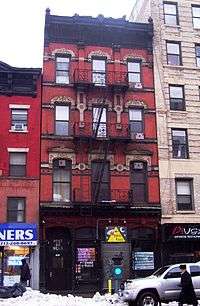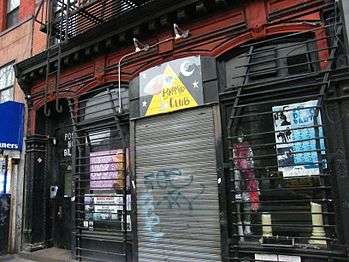Pyramid Club
|
Entrance to the club in 2009 | |
| Address | 101 Avenue A |
|---|---|
| Location | New York City |
| Coordinates | 40°43′33″N 73°59′02″W / 40.72578°N 73.983873°WCoordinates: 40°43′33″N 73°59′02″W / 40.72578°N 73.983873°W |
| Type | Nightclub |
| Opened | 1979 |
| Website | |
|
thepyramidclub | |

The Pyramid Club is a nightclub in the East Village of Manhattan, New York City. After opening in 1979, the Pyramid helped define the East Village drag and gay scenes of the 1980s. The club is located at 101 Avenue A in Manhattan.
In the late 70s and early 80s, when mega-clubs like Studio 54 and The Limelight, dominated New York nightlife, the struggling artists, actors, musicians, and drag queens who lived in the East Village created their own, more intimately-scaled scene. They began taking over some of the local dive bars, such as the Holiday on St. Mark's Place, and created new clubs where there previously were none, as was the case with Club 57[1] (in the basement of a church), and 8BC, on a block of abandoned tenements.
The club became a hangout for "a new breed of politicized drag performers" like Lypsinka, Lady Bunny, and RuPaul, whose first New York City show was at the Pyramid Club in 1982. On Labor Day 1985, Pyramid performer Lady Bunny hosted the Wigstock Festival in Tompkins Square Park. [2] Andy Warhol and Debbie Harry dropped in the Pyramid to do a feature on the club for MTV, and Madonna appeared at her first AIDS benefit at the club. Both Nirvana and Red Hot Chili Peppers played their first New York City concerts there. From 1992-95, Blacklips Performance Cult, a collective founded by Antony Hegarty, presented plays at Pyramid every Monday at midnight.
In 2007, it was proposed that 101 Avenue A, the Pyramid Club's building, be landmarked. The proposal, described as the first "drag landmark", was not adopted by the New York City Landmarks Preservation Commission.[3] However, in the spring of 2011 the Landmarks Preservation Commission proposed a new historic district in the East Village focused around lower Second Avenue and encompassing 15 blocks and 330 buildings. The original proposal excluded buildings such as the Pyramid Club, but thanks to efforts made by local community groups such as the Lower East Side Preservation Initiative, East Village Community Coalition, Historic Districts Council, and Greenwich Village Society for Historic Preservation, the proposed district now includes 101 Avenue A as well as other similar buildings. The Landmarks Preservation Commission designated the East Village/Lower East Side Historic District on October 9, 2012.[4]
Performers
See also
References
- Notes
- ↑ Magnuson, Ann (1999). "Club 57". ArtForum.
- ↑ Woodruff, Sheryl. "Pushing the Envelope on Avenue A". Greenwich Village Society for Historic Preservation. Retrieved June 29, 2011.
- ↑ The Villager. "Push to make Pyramid Club city's first 'drag landmark'".
- ↑ "East Village/Lower East Side Historic District Designation Report" (PDF). NYC Landmarks Preservation Commission. Retrieved 1 October 2014.
- ↑ "They Might Be Giants, Again: The Adult Comeback of a Cult Band". Grantland. Retrieved 6 January 2015.
